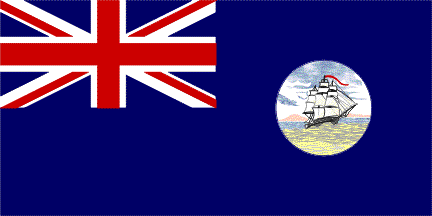
Blue ensign
image by Martin Grieve, 24 June 2003

Last modified: 2014-04-16 by zoltán horváth
Keywords: guyana | demerara | essequibo | berbice | ship | british guyana |
Links: FOTW homepage |
search |
disclaimer and copyright |
write us |
mirrors
See also:
Originally "Dutch Guiana" consisted of four colonies
(from west to east): Essequibo, Demerara, Berbice, and Suriname.
The three first became British in 1814 and some years later they
were united into one colony: British Guiana. They were occupied
already earlier by the British (to keep it from the French,
approved by the Prince of Orange in exile), like the Suriname,
the Antilles and East Indies, who became Dutch again, and Ceylon
and the Cape, who remained British.
Mark Sensen, 6 May 1998
A coastal scene with one or more ships was often part of the
seal of a British colony in the latter part of the 19th century,
and this was used as the badge of the colony if there was no
obvious local emblem. Although the British Guiana badge is unique
in having just one ship and no coastline, it is unlikely that the
drawing was meant to represent any particular ship.
The ship in the original circular badge of 1875 is different from
the ship in the oval badge enclosed in a yellow garter of 1906,
which is different again from the badge that was taken from the
arms granted in 1954. The 1906 badge had been criticised for
having a number of nautical anomalies, and in 1953 the Colonial
Office asked the Admiralty for help in ensuring that the arms
were correct from a seaman's point of view. If the badge had been
meant to represent a particular ship I'm sure it would have been
mentioned at that time.
David Prothero, 17 Febuary 2003
British Guiana used a circular seal in 1875 flag. It was
changed to circular seal in oval garter in 1906. It was changed
to the arms in 1954.
David Prothero, 8 April 2005

Blue ensign
image by Martin Grieve, 24 June 2003
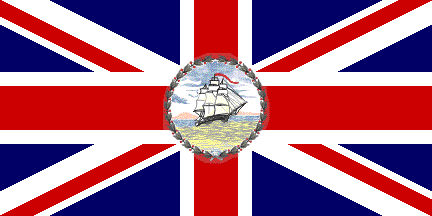
British Guyana governors
image by Martin Grieve, 24 June 2003
The red ensign was unofficial. Old designs (before 1919)
showed white disk in the blue and red ensign .
Jaume Ollé, 6 Febuary 2000
1875-1906. Circular badge having a starboard bow view of
three-masted square-rigged sailing ship filling the whole of a
standard 4/9th circular badge. On UJ and Blue Ensign. Presumably
derived from local scene panel of the seal of the colony. Not
very distinctive of the locality, but one of the better circular
badges.
David Prothero, 5 Febuary 2000
It has been noted that there was no official
defaced red Ensign, and that seems to bear up with some
literature here on my bookshelf.
"Commercial vessels flew the British merchant flag, i.e. the
Red Ensign without any badge"
Source: The Flag Bulletin XXI:4/95 "Flags of
Guyana" by Father David Drake-Brockman
So there we have it - 2 flags were most definitely in existence
and these were:
1. A Blue Ensign: for armed and unarmed government vessels.
2. A Governor's flag: badge enclosed in garland on Union flag.
Martin Grieve, 23 June 2003
bg75.gif)
image by Martin Grieve, 13 April 2008
David Prothero supplied me with a scan of the
"official" badge of the British Colony which defaced
the British Blue Ensign between the years 1875-1906. In this
badge there is no ensign at the stern, but rather just a masthead
pennant in British Navy red flying from the main mast.
Martin Grieve, 23 June 2003

Red ensign (dubious and anyway unofficial)
image by Martin Grieve, 27 June 2003
Unless there is convincing proof that there was such an
unofficial ensign I think it should be consudered very dubious.
In my humble oppinion, it had never existed.
David Prothero, 27 June 2003
I have to support David on this one. Even an 'unofficial'
defaced Red Ensign does seem extremely unlikely for late-19th
Century British Guiana.
Christopher Southworth, 27 June 2003
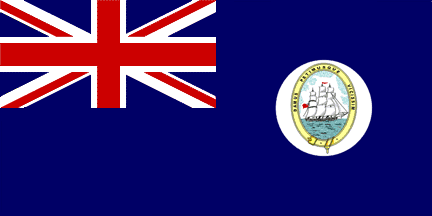
Blue Ensign
image by Martin Grieve, 18 April 2008
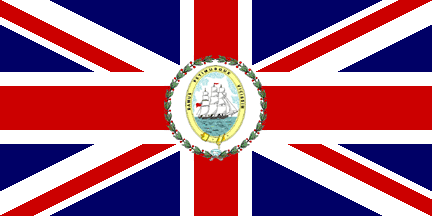
Governor of British Guiana
image by Martin Grieve and Jaume Ollé, 18
April 2008
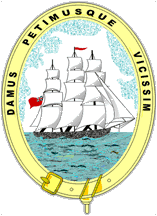
Badge
image by Martin Grieve, 18 April 2008
Flaggenbuch [neu92] shows the
badge as an oval 'garter' with the motto 'Damus Petimusque
Vicissim' on it (within a white circle on the red ensign, but not
on the blue one), exactly as depicted in the Colonial Badge
Santiago Dotor , 1 Febuary 2000
Between 1905-1919 was the same .
image by Jaume Ollé, 6 Febuary 2000
1906-1955: The badge in the garter was in use from 1906
to 1954 - Similar view of the ship as in 1875
, but now much smaller and enclosed in the garter that was
described by Santiago. I'm not sure if garter is the correct
term. I have seen it described as a "belt and buckle".
On UJ and BE. On the BE it was placed on a white disc until
1919. Replacement flags after that had no white disc.None of the
badges was an official defacement of the Red Ensign
David Prothero, 5 Febuary 2000
The 1939 Flaggenbuch edition [neu92]
includes this flag. It is mentioned that the badge is (was) used
only on the Blue Ensign
Ivan Sache, 4 October 2000
Here is a photo of a badge
on white disc taken by me at a flag display in ICV 19 (York, July
2001). The origilal flag is from Clay Moss collection.
According to the display catalouge: "The motto translates
as: "We give and seek in return."
This version may have been unofficial or its origin is not clear.
Dov Gutterman, 31 July 2001
Illustrations are based on the badge defacement illustrated in
"Das Grosse Flaggenbuch 1992", which in turn copied the
"Admiralty book of flags 1907". The basic difference in
the drawing is the sea. Admiralty book of flags shows a choppier
greener sea, whilst Flaggenbuch displays a smoother blue version.
From "The Flag Bulletin XXI:4/95"(July-August 1982),
Father David Drake-Brockman wrote: "From about 1900 till the
end of 1954 a slightly different version of this badge [He was
reffering to the first badge of the Colony,MG] was in use. The
ship, flying the Red Ensign, sails within an oval garter-like
yellow scroll around the top part of which is written the motto
also found in the seal".
British Guiana adopted new Arms in 1954 and this was provoked by
requests received by the British Guiana Government three years
previously. Upon investigation it was determined that the seal
and flag badge long in use had no official standing in armorial
form. When the request was sent through to the Secretary of State
for the Colonies to the College of Arms, it was pointed out that
some criticism of the old design had been made because the wind
seemed to be blowing the sails and the flags of the ship in
opposite directions.
I do not know if the badge was ever placed directly on to the
Blue Ensign (i.e. without white disk.)
Martin Grieve, 18 April 2008
Flag without white disk (?)
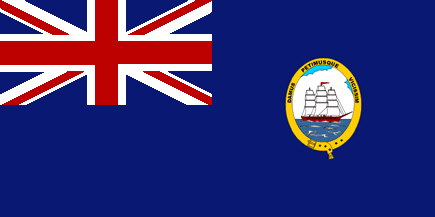
image by Jaume Ollé, 6 Febuary 2000
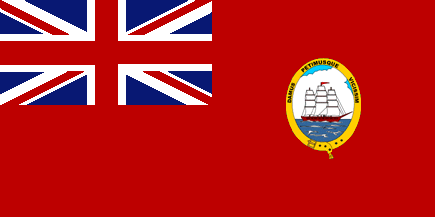
image by Jaume Ollé, 6 Febuary 2000